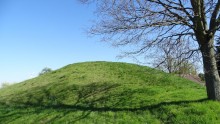|
|
|
|
Baalberge SchneiderbergRound Barrow(s)
|
||||||||||||||||||
|
|
|
Images (click to view fullsize) |
|
Photographs:



 Maps / Plans / Diagrams:
Maps / Plans / Diagrams:




|
Fieldnotes |
|
|
The Schneiderberg is a burial mound of the Neolithic and the Bronze Age in Baalberge, a district of Bernburg (Saale). During an excavation in 1901 ceramic vases of an archaeological culture were first discovered here, which later received the name Baalberger culture. So Schneiderberg became the eponymous site for this culture. The hill has a height of 5.57 m and a circumference of 133 m. Its top is flattened and forms a plateau with a diameter of 8 m. The hill was probably originally surrounded by a ditch, but was heaped up in the 19th century. The Schneiderberg - Baalberge is located within a allotment garden. Coming from Bernburg, follow the main road Bernburger Straße (L146) first and then leave it at the first slight right-hand bend, going straight on into the bypass. After the second house on the left side, turn left and continue straight ahead until you reach the entrance to the allotment garden. There you can park. The burial mound is then a few meters further. Visited April 2019 |
6th June 2019ce |
|
taken from the information board Arbeitskreis Archäologie im Bernburger Land e.V.: Der Schneiderberg (Tailor Hill) Middle and Late Neolithic: Baalberger culture approx. 4,100 - 3,400 BC Walternienburg-Bernburg culture approx. 3,300 - 2,700 BC Globular Amphora culture approx. 3,100 - 2,700 BC Corded Ware culture approx. 2,800 - 2,200 BC Early and Late Bronze Age: Unetice culture approx. 2,100 - 1,600 BC Saale estuary group approx. 1,300 - 700 BC The Schneiderberg is one of the burial mounds of the Bernburg region, which achieved special fame in archaeological research. His excavation took place in 1901 by the Bernburg History and Antiquity Society under the direction of Ferdinand Kälber and authoritative participation of Paul Höfer (1845-1914), a renowned historian and archaeologist, who later also earned lasting merits in the careful study of the Pohlsberg at Latdorf (1904). The stratigraphic observations made on both burial mounds significantly contributed to the clarification of the chronology of the Middle German Neolithic period. The stone slab grave in the center of the hill (length: 1.5 m / width: 0.8 m / height: 1.1 m) with a mighty cover plate (about 2.3 mx 3 mx 0.3 m) was about 5.3 m below the hill plateau and contained a bodily burial and two characteristic vase additions (jug and cup, see figure). These were later named for the Baalberg culture of the Middle Neolithic. On the side of it was found as a burial a split stone slab grave with body graves of the Walternienburg-Bernburg or Globular Amphora culture. In the upper mound to the northwest of the central tomb, a body tomb of the Corded Ware culture with a cord cup, oyster pot and silex blade was uncovered. Above the central grave followed several stone boxes with burials of the early Bronze Age, partly with dagger accessories. Finally, some destroyed stone boxes in the lateral mantle of the hill are mentioned, which presumably contained urn graves from the late Bronze Age. In the immediate eastern neighborhood of the burial mound in 1990 a multi-phase settlement site of the late Bronze Age to early Iron Age and Early Bronze Age graves were uncovered. |
5th June 2019ce Edited 5th June 2019ce |

